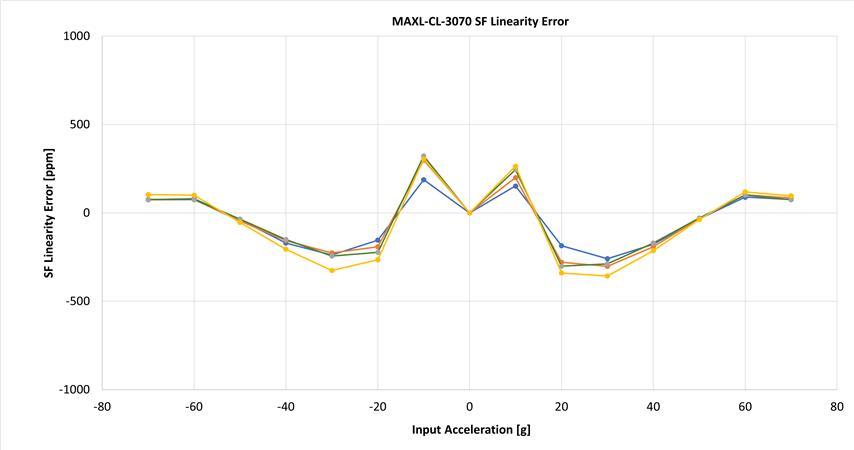Physical Logic is proud to introduce several new products based on the flagship accelerometer family of sensors, the MAXL-CL-3030. Physical Logic now offers the same proven technology for higher sensing ranges: the MAXL-CL-3050 for input range up to 50 g and the MAXL-CL-3070 for input range up to 70 g.
 For over 2 years, the MAXL-CL-3030 accelerometer family of sensors, has provided to the market a high performance and low CSWaP MEMS accelerometer for tactical and navigation applications for input range up to 30g. The advantage of the Closed Loop configuration over the Open Loop configuration has been clearly proven. The excellent Scale Factor linearity and stability is far superior to any Open Loop MEMS accelerometer which manifests itself as well as very low Vibration Rectification Error (VRE). In addition, the Bias Stability and Temperature Sensitivity is clearly improved as compared to an Open Loop configuration with the same sensing range. In 2020 Physical Logic introduced a new MAXL-CL-3030 revision with 1 year bias repeatability below 500 µg.
For over 2 years, the MAXL-CL-3030 accelerometer family of sensors, has provided to the market a high performance and low CSWaP MEMS accelerometer for tactical and navigation applications for input range up to 30g. The advantage of the Closed Loop configuration over the Open Loop configuration has been clearly proven. The excellent Scale Factor linearity and stability is far superior to any Open Loop MEMS accelerometer which manifests itself as well as very low Vibration Rectification Error (VRE). In addition, the Bias Stability and Temperature Sensitivity is clearly improved as compared to an Open Loop configuration with the same sensing range. In 2020 Physical Logic introduced a new MAXL-CL-3030 revision with 1 year bias repeatability below 500 µg.
Focus on High Sensing Range
For many navigation applications, there is a requirement for a sensor, in addition to providing all the above advantages, that can also measure input accelerations higher than 30 g, up to 50 – 70 g. There are several approaches to increase the sensing range, however, the challenge is to find the way that will minimize the penalty in terms of other performance parameters. The engineers at Physical Logic got busy tackling this challenge. For several months, a concentrated effort led to a deep understanding of the error budget for a MEMS accelerometer in Closed loop operation.
In Open Loop operation the sensing range of the accelerometer is usually proportional to the spring constant. Since increasing the spring constant to achieve a higher sensing range also increases the Bias charge sensitivity, this will automatically lead to a penalty in the performance for higher sensing ranges. For many applications this is a tradeoff that is acceptable, however for navigation grade accelerometers, high performance and high sensing range are both necessary.
In Closed Loop operation, using capacitive sensing and feedback MEMS accelerometers, the above tradeoff between performance and sensing range no longer applies. The sensing range is strongly determined by the feedback voltage. In this way, the MEMS design can be optimized for performance and not only for sensing range.
However, to do the design properly, it is necessary to consider the theoretical error budget for an accelerometer under closed loop operation. Physical Logic has developed a strong understanding of these issues and has developed and verified a theory for the Closed Loop errors.
A proper MEMS design allows to achieve low bias sensitivity and to enable best performance over temperature and time.
High Range and Excellent Performance

The first production units of the MAXL-CL-3050 and the MAXL-CL-3070 have gone through typical acceptance tests including temperature, vibration, and centrifuge measurements and analysis. These units have shown excellent Scale Factor linearity up to the high sensing ranges of 50 g and 70 g with a minimal penalty for the other performance parameters.
